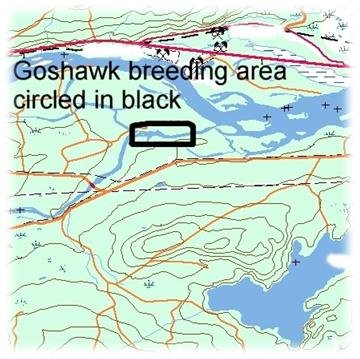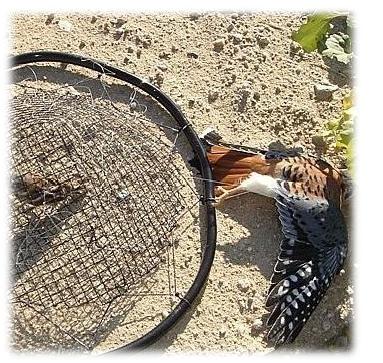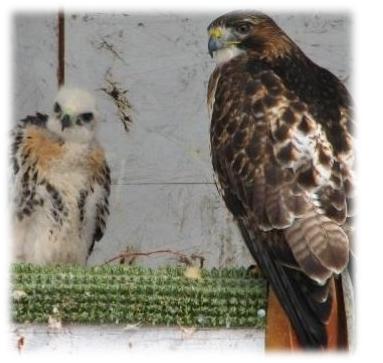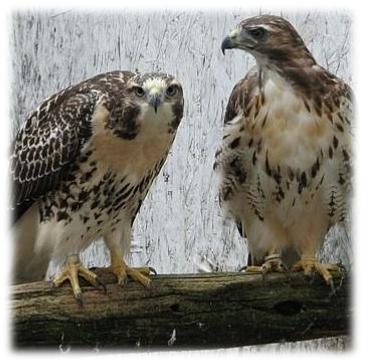Raptor Populations in Newfoundland
Luckily most raptor species in Newfoundland and Labrador are thought to have maintained population levels that reflect pre-European contact and are protected from human hunting under both Federal and Provincial laws. While some species requiring old growth forest have suffered habitat losses due to clear cutting and still others as a result of pre-commercial thinning of regenerating forest cover, some species seem to flourish as a result of modern forestry and agricultural practices (e.g. rough-legged hawk , northern harrier, etc). Given the recent closure of two of the three paper mills it is expected that over the coming decades a shift in raptor populations favouring raptor species that require regenerating forests, and eventually old growth forests, will be seen in these two regions. In general, our raptor populations seem to be faring well and are fairly pristine. Exceptions include the southern breeding variety of peregrine falcon, both bald and golden eagles, and a few species which likely only ever had a very small population in our province due to a lack of ideal habitat or competition from a more dominate species. These infrequent raptors would include such species as the red-tailed hawk, coopers hawk, short-eared owl, long-eared owl, rough-legged hawk in Newfoundland, and perhaps a few others.
A recent success story is the continual repopulation of the peregrine falcon which was recently taken off the endangered species list in the USA. Newfoundland played an important role in this effort by donating adult peregrines to a massive breeding project in Alberta. In Newfoundland there are thought to be two of the three Canadian subspecies - anatum and tundrius. However, due to there being only slight differences in these subspecies many people simply lump them together as eastern peregrines. To add to this reasoning, the subspecies may naturally interbreed and the bloodlines were mixed in artificial breeding programs run by the government during repopulation efforts. Thankfully, no peregrines were released in our province by these re-introduction programs and our populations remain untampered with. The southern breeding variety that is found below the tree-line in Labrador and perhaps on the Island portion of our province is still very much in recovery in these areas, despite having over 1000 known birds in the Canadian anatum subspecies population in 2007. We are currently investigating the possibility of the first reported breeding pair of peregrines on the Island portion of our province. However, the arctic and northern populations (whether anatum and/or tundrius ???) found throughout northern Labrador, and seen migrating in our sky during the spring and fall, are doing very well with a population that is now thought to number in the thousands of birds in Canada and is well on its way to total recovery (in these regions). Limited surveys conducted in various regions of Canada recently found 1168 mature birds of these two subspecies. It was reduced from being listed as endangered, to threatened, and was recently further downgraded to being listed as 'vurnerable" under schedule C of the Provincial Endangered Species Listing Regulations . Currently, no recovery plan is in place or being implemented (despite a lack of a breeding population on the Island portion of our province). 63 historical nest sites were monitored in Labrador on occassion and the list of sites is continually being added to through new sites being identified. The critical threat to this species, namely pesticides, seems to have been reduced such that we now see expanding populations and good reproduction during good climate and food availability years. Please see the latest federal government SARA status report on this species. "Populations increased by 43% in occupied sites in southern Ontario and by 107% in southern Quebec, which suggests that Peregrine Falcon populations are almost as abundant as they were before the collapse resulting from the use of organochlorine pesticides" SARA 2007. "Dramatic increases in populations were seen from 2000 to 2005" SARA 2007. SARA continued to delist the two subspecies found in NL. They now are listed as "no status" which basically takes it off all its lists. COSEWIC also delisted it continually over the last two decades and now simply lists it as a species of "special concern".
A good frequently asked questions site about the peregrine falcon can be seen here. Some suggest that the delistings were too soon (see Mark Nash ).
In an effort to help monitor the raptor populations in our province we encourage members to report any unusual sightings and especially any summer sightings of: peregrines, gyrfalcons, and bald and golden eagles as well as raptors that rarely breed here. We are currently investigating developing a monitoring site in western Newfoundland for migrating raptors such as merlins and peregrines. A major North American organization that has been conducting such monitoring for decades is the Hawk Migration Association of North America http://www.hmana.org/ An on-line and off-line program is available for schools that grants students access to cutting edge wildlife tacking being done in North America including satellite tracking of peregrines. For more information please visit: http://www.earthspan.org/education/eye-of-the-falcon/
We also encourage members and the public to contact us concerning any nesting sites that may be in immediate danger even if the species is a common one such as a Northern Harrier, Goshawk, Merlin, Hawk Owl, Boreal Owl, Great Horned Owl, Sharp-shinned Hawk, Kestrel, etc. A dedicated group of ornithologists (people that study birds) in Canada is the Bird Studies Canada Organization . They conduct research throughout Canada and we are more than happy to assist in their efforts. Another group is eBirds Canada where sightings can be recorded and mapped. Members of our association contribute to this database. It is used by raptor scientists and enthusiasts alike.
We hope to have a list of all research done on raptors in the province soon and hope to post the list on this site. A worthy charitable scholarship that the newly formed association will be donating to is the Neal Simon Memorial Trust which aides budding ornithologist. Dr. Simon was a dedicated ecologist and avid waterfowler and upland bird hunter, and is sorely missed.
Our association also maintains maps of all reported raptor nest sites and we encourage everyone to participate in this effort. Our provincial Wildlife Division is also mapping all known bald eagle nesting sites on the Island and we are happy to pass along to them any information we can gain on this subject. There have also been several GPS satellite tracking studies conducted on osprey and bald eagles by the Wildlife Division and environmental research companies. Several of our banded raptors have shown up in places as far away as Brazil, Texas, Florida, and other tropical locations.
| |
 | | |
Does Falconry Have A Negative Effect on Wild Raptor Populations?
Falconers have long been on the frontlines of raptor conservation in North America. One of the world's largest raptor conservation organizations - the Peregrine Falcon Fund - has spearheaded much of the raptor research that has been done in the Americas. Similarly, other raptor research organizations are often lead by falconers (e.g. Raptor Research Foundation and the Journal of Raptor Research ). It is through the efforts of falconers that many laws protecting raptors and their habitat have been established. Moreover, it was the efforts of falconers that resulted in methods used in the captive breeding of many species of raptors. These techniques have been used in efforts to help repopulate species such as the peregrine falcon. Often it is falconers that map and record nesting sites, obtain detailed ecological information about raptors in a region through observations, and report any problems in raptor populations such as unusual die offs or disease outbreaks. If you live in many provinces other than NL or you live in the USA and see a peregrine - you can thank falconers for it.
Typically, raptors have very low survival rates in the wild. For most species with a stable population, in most regions, a typical figure would be that 80% will not survive their first year. For example, one of the most common raptors in our province that is used in falconry, the Northern Goshawk, in the largest study ever conducted on the species in North America, was shown to have an average life span in the wild of 11 months. Only a very small percentage that are produced annually will survive to secure a home range and breed. Many raptor populations fluctuate naturally with prey abundance. Wildlife biologists suggest that an annual harvest rate of 5% of the population is highly sustainable. For details please see the recent study: Effects of Falconry Harvest on Wild Raptor Populations in the United States in the Journal of Wildlife Management. In regions in Canada where falconry is most heavily practiced, less than 0.01% of any raptor species is retained for falconry purposes. This ranks raptors as some of the most under-utilized harvested wildlife in North America. Due to its very nature, there will never be many falconers in today's world. Falconers generally obtain raptors in one of four ways.
1) By removing an eyass (young raptor) from a nest site before it is flying well. This is done in such a way as to virtually eliminate any possible negative effects on the number of young that would survive to breed. Raptors produce more young than will survive naturally. For example, if a raptor typically lays three or more eggs it is extremely unlikely that the last egg will produce a bird that lives to sexual maturity and enters the breeding population. By obtaining such surplus young and providing a far more safe and protected environment a falconer will most likely ensure that any young raptor obtained will survive past the first and critical year of life. Moreover, by removing a surplus nestling the survival rate within the clutch increases dramatically.
2) A more traditional method is trapping passage birds. These are the young of the year that have survived long enough to be flying and are learning to hunt and feed themselves. They may join or may already be part of the fall migration. They have not yet tried to carve out a home range or breeding territory and are typically only months old. Most will not survive to breed. Falconers humanely trap these birds using traditional and globally accepted methods. Most are banded for scientific purposes and released but a lucky falconer may trap one of special interest and retain it to train and hunt with. The vast majority are released the following year with the bird having gained hunting and survival skills under the watchful and protective eye of the falconer. As a result of this human-raptor interaction, the likelihood of these bird surviving to breed is significantly higher.
|
 | |
3) Falconers are often called upon to be wildlife rehabilitators. Most regions have far more raptors turned in than can be adequately or sensibly cared for. Falconers help ease the burden on these rehabilitation centres by providing expert care and training for these raptors at the expense, in terms of time and financing, of the falconer. Most, if not all, are later released back into the wild or if this is not possible retained for captive breeding purposes.
4) Falconers can purchase birds from breeders.
|
 | |
I have found a raptor(s) on the ground or barely able to fly during July or August, what should I do?
Chances are this is what falconers call a brancher. This bird may look just like an adult bird (see picture below of a brancher to the left of an adult), but is still learning to fly. For a short period of time during late summer raptors go through a very dangerous time in their development. They are learning to fly and climb around on the branches and ledges near the nest site while exercising their flight muscles. Every year people in our province encounter raptors at this stage of life. We encourage people to simply leave nature take its course. The parent birds are still providing food to these young birds and will also provide defensive protection. Even if you have not seen another adult raptor nearby, it is best to leave the young bird where you seen it. If it is in an area often frequented by humans, you may wish to report the incident to the nearest wildlife office. Some species of raptors can become dangerous to humans if we approach the nest site or young. It is best to vacate the area immediately and count yourself as one of the lucky few that have seen such a thing in nature.
 |
|



